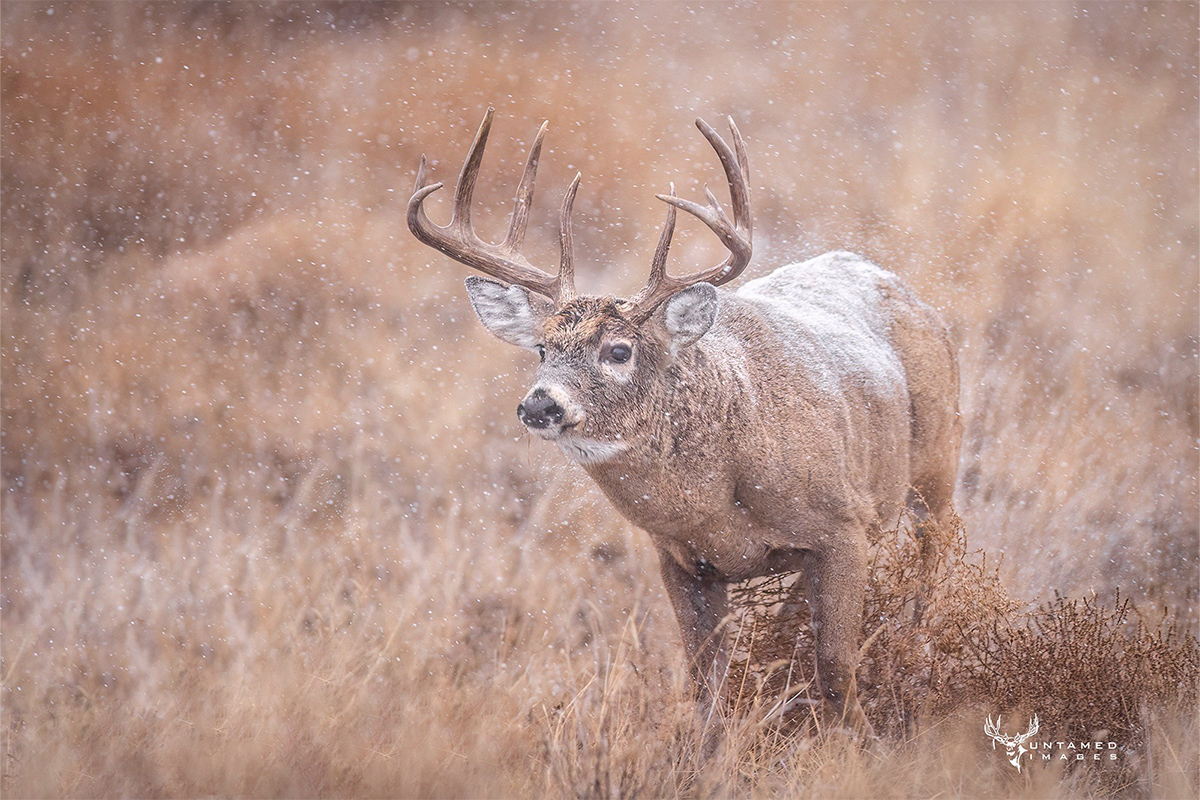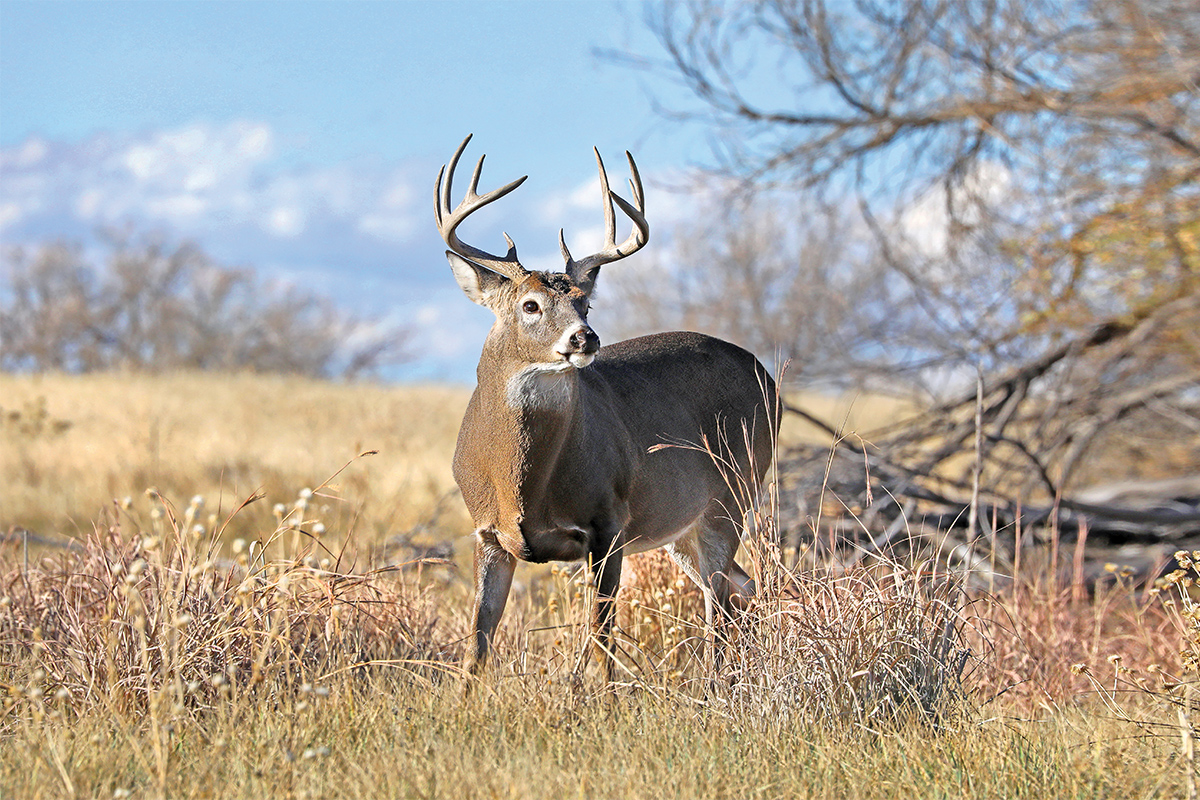
Photo by Untamed Images by Jason Loftus
Take a peek at any social media hunting page or scroll through Instagram on a weekend leading up to an October bow-season cold front, and the energy may feel similar to NFL fans tailgating prior to a conference title game to punch a ticket to the Super Bowl. Excitement, anticipation and sleepless nights fill the comments section, and everyone fully expects the upcoming weather will surely get whitetails on their feet in daylight. You text a few buddies Friday night and sure enough, they have plans to be in their sacred tree also.
In the aftermath of the weekend, you check out a few online pages, and you guessed it, dozens of great bucks were taken across your state. This was surely due to the weather’s impact on deer, right?
Well, not so fast. Research out of Mississippi State University shows otherwise. Let’s look at data from the study, and then ask a few well-known hunters what they think.
The Setup
Collared research of 32 deer (17 does and 15 bucks) conducted in 2010 out of Mississippi State University aimed to solve the debate of weather influencing deer movement. Researchers collected data from the 35 deer throughout 3,000 acres of the Samuel Roberts Noble Foundation Wildlife Unit in Oklahoma. An 8-foot tall fence was in place around the study area, but their findings showed the fence allowed for deer to pass through, and minimally affected a whitetail’s home range throughout the study. High-tech collars provided results throughout the day and gave researchers a clue into what weather factors, if any, might be affecting movement. Hunting is allowed in this area and was mentioned in the research as a possible factor to movement.

For the researchers to collect realtime data, they totaled the distance moved by each deer within 3-hour time periods throughout the day. Comparing the distance moved to the real-time weather data was critical to their findings. While the general goal of the study was to determine how weather conditions affected deer movement, they also report how time of year affected deer travel. It’s important to note this study was conducted in the southern Great Plains climate of Oklahoma.
Science Says
Take a deep breath and gather yourself. The cold fronts and high barometer blue bird days we plan family gatherings and vacation around don’t affect deer movement like you think, according to the science discovered in this research. Mississippi State University and the Mississippi State DeerLab is a well-known institute in the circle of whitetail researchers. Bronson Strickland, Professor of Wildlife Management at Mississippi State, answered a few of these weather-related questions pertaining to the research that was conducted.
On the Down South Hunting podcast in 2018, Strickland referenced the research and said: “Let’s say you’ve got two days you can hunt. One day is above average temperature, and the next day is going to be a little colder. Which day are you going to hunt? You are going to hunt the colder day, because you have in your head the deer are going to be moving. You won’t be swatting mosquitos, and it will be a more pleasant sit.”
But according to this research study, in which Strickland contributed to, it appears much of the recorded whitetail movement revolved around the time of year, rather than changes in weather conditions. According to the study results, “In general, we found minimal evidence that weather was having an influence on deer movements. Deviations from normal seasonal weather conditions did not reveal consistent patterns or changes in movement.” Furthermore, they concluded “moon phase had no noticeable influence on movement.”

Whitetail travel throughout the study was mostly “crepuscular” — meaning they moved mostly during the hours of dawn and dusk. Although the study shows movement results by moon phase, they don’t touch on the positioning of the moon or whether the moon was rising before dusk, which is what a lot of hunters claim increases deer movement. More on that later.
Throughout the research, they found bucks change their daily movement patterns most in response to the breeding period, which isn’t shocking. In fact, buck movements were 20 percent greater during the rut than the post rut. The study also shows a large decrease in daylight buck movement during winter, which could’ve been a reaction to hunting pressure within the research area, or deer trying to recover from the rut. I see similar evidence of this in my “real-world” hunting, so it’s important to note the similarity.
Increased female deer movements were also contributed to the rut and breeding timeframe, but females in this study moved the most in the period following the birth of their fawns. The study claimed an increase in energy requirements and the demands from lactation likely contributed to this.
Researchers in this study claim if there was one weather factor slightly affecting deer movements, it was temperature. Barometric pressure, precipitation, and moon phase did not affect notable changes in deer movement. The study claims: “Males during winter moved more when temperatures were lowest. Bucks may have moved more during winter evenings when temperatures were reduced, in preparation of further drops in temperature during night.
“Therefore, males may have foraged more intensively, or moved longer distances during the evening to reach favorable thermal habitats,” the study continues. The research did not comment if there was a correlation between temperature and rut movement. Now, let’s hear from the “real-world” guys.
They Beg To Differ
So, back to that first October cold front you were dreaming up. Although the MSU research suggests weather might not strongly affect deer movement, successful and well-known hunters have a story of their own. In fact, Drury Outdoors’ own Mark Drury believes weather influences deer movement so much that he and his team created an app called DeerCast centered around their experiences.

Mark reports: “If I closely monitor weather patterns on my farm for any given 10-day period, I can accurately predict when deer are going to move and when they won’t. You can watch the same field 10 nights in a row; on two or three nights you’ll see 40-50 deer, and other nights you may only see one or two. In my opinion, it’s all dependent on weather fronts, and barometric pressure plays a huge role.”
Well, it’s hard to argue with a guy like Mark Drury. Mark hunts somewhere nearly every day of deer season and has as much firsthand evidence of deer movement as anyone out there. When he says deer move depending on weather, I tend to believe him.
Even though Mark hunts highly managed properties with great buck-to-doe ratios and herd numbers, I see the same patterns hold true regarding deer movement and weather, no matter if I’m hunting public land, my family’s property or a small 16-acre piece I have permission on. I have sat (regrettably) many boring days in a deer stand during warm weather conditions. For me, it’s simple — I don’t see as many deer when weather conditions aren’t what most would consider “favorable.”
Here is my theory on deer movement, especially as it pertains to the whitetail rut. Optimal weather conditions such as clear, cold skies with high barometric pressure tend to expose daylight portions of deer movement that would otherwise happen under the cover of darkness. Even Bronson Strickland admits: “My human bias wants to believe those cooler days will have more deer moving, but our research shows weather conditions had an inconsistent influence on deer movement within the season.”
While appearing on the Wired to Hunt podcast in 2018, Mark Drury said: “A front in September does not affect deer the same as it does in the middle part of November, or as it does in the middle part of December, because deer metabolism is at different levels during each of those time frames. Give me a high-pressure day with a northwest wind during the peak of the rut, and watch how many bucks you see walking hundreds of yards.”
You’ll Hunt Anyway, Right?
Many of us, myself included, don’t have the luxury to only hunt the prized cold fronts. If a cold front happens on a Tuesday in mid-October, I don’t always have the vacation stored up to bolt off into the woods. If there is a normal weather day during the hunting season and I’m free to go hunting, I’ll probably go.
Aligned in that same thinking is Dan Johnson, CEO of the Sportsmen’s Nation and host of the Nine Finger Chronicles podcast. Dan told me: “As someone who has a family, full time job and other responsibilities, when I get the time to hop in the tree stand, I’m not thinking about weather at all.”
I fall into both camps. Like Dan, I will probably go hunting whenever I get the chance, but I do believe those crisp, cool mornings and evenings get deer moving — because I see it firsthand in the stand and on trail cams. I run approximately 20 CuddeLink trail cams on a 115-acre property I hunt, and I can predict with great accuracy when deer will and will not move based on the impending weather fronts.

Dan continued in our exchange, saying: “One of my favorite times to be in the tree is after a long period of rain. I have killed some of my best bucks the first afternoon after a 24- to 48-hour rain event. For one reason or another, it seems to get them off their feet and looking for food or to freshen up scrapes, especially if it falls in that mid to late October timeframe.”
Jared Mills, of the popular online show Midwest Whitetail, agrees with Dan that weather will not keep him from hunting. In regards to barometric pressure specifically, Jeremy says: “I pay a lot of attention to barometric pressure, but it doesn’t dictate when I hunt. I pay attention so I can learn more about deer movement in general. For me, it seems to be a very critical factor, but I am still that guy who doesn’t miss any opportunity to be in the woods.”
Go With What You Know
While the research out of MSU is intriguing and revealed some general patterns we may not have seen before, due to the thoroughness of the study, only you can determine when the best time is to hunt.
Research conducted in Oklahoma can’t speak for hunter-observed movement in a tucked-away food plot in Missouri, a swamp in the big woods of Michigan or a green field nestled between pine plantings in Georgia. If your eyes and your trail cameras tell you that deer movement is influenced by a certain weather factor, trust it. And go hunt.











































